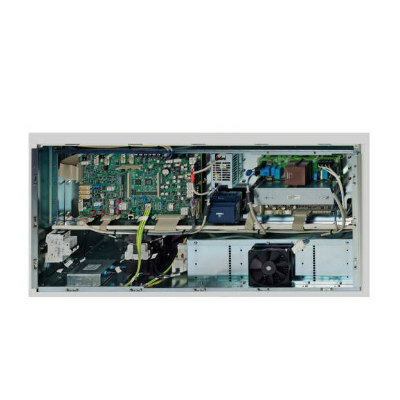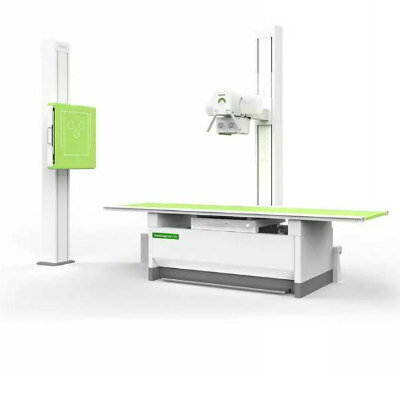AI-Supported Mammography Screening Detects 20% More Cancers and Halves Radiologist Workload
|
By MedImaging International staff writers Posted on 03 Aug 2023 |

Mammography screening for breast cancer has been proven to enhance prognosis and lower mortality by early detection of the disease, enabling timely treatment. However, it is estimated that 20-30% of interval cancers, which should have been detected in the prior screening, are overlooked, and numerous suspicious findings often prove benign. To ensure high sensitivity, European guidelines advise having two radiologists review the mammograms, but there's a shortage of breast radiologists in many countries and it takes over a decade to train a radiologist in becoming proficient in reading mammograms.
Artificial intelligence (AI) has been suggested as a potential automated second reader for mammograms, which could lessen the radiologist’s workload and enhance screening accuracy. The technology has shown promising results in retrospective studies using AI to triage examinations to single or double reading and aiding radiologists in identifying suspicious features to reduce false negative results with the use of computer-aided detection (CAD). However, there has been very less solid evidence from prospective randomized trials to support this. Now, an interim safety analysis of the first randomized controlled trial of its kind, involving over 80,000 Swedish women, has discovered that AI-assisted mammography analysis matches the efficacy of two breast radiologists in detecting breast cancer, without an increase in false positives and reducing the screen-reading workload by nearly half.
In a study conducted by researchers at Lund University (Lund, Sweden;), 80,033 women aged 40-80 years who underwent mammogram screening at four locations in southwest Sweden from April 2021 to July 2022 were randomly assigned to either AI-supported analysis (where a commercial AI-supported mammogram reading system examined the mammograms before one or two radiologists also read them) or standard analysis carried out by two radiologists without AI support. This initial assessment of the Mammography Screening with Artificial Intelligence (MASAI) trial compared early screening performance and screen-reading workload between the two groups.
The minimum clinically acceptable limit for safety in the AI-supported group was set at a cancer detection rate exceeding three cancers per 1,000 screened women. The assumption was that the detection rate might fall as the majority of screening exams would undergo single reading instead of double reading. The baseline detection rate with double reading in the current screening program is five cancers per 1,000 screened women. In the AI-supported analysis, the AI system initially analyzed the mammography image and predicted the cancer risk on a scale from one to ten, with one being the lowest risk and 10 the highest. Images with a risk score below 10 were further analyzed by one radiologist, while images with a risk score of 10 were analyzed by two radiologists.
The system also offered CAD marks to aid radiologists in interpreting mammography images accurately. Women were recalled for further testing in case of suspicious findings. Radiologists made the final decision to recall women and were instructed to recall cases within the top 1% risk, barring clear false positives. AI failed to give a risk score in 0.8% of cases (306/39,996), which were referred to standard care (double reading). The recall rates averaged 2.2% (861 women) for AI-supported screening and 2.0% (817 women) for standard double reading without AI. These were similar to the average 2.1% recall rate in the clinic six months before the trial began, indicating that there was no decline in the cancer detection rates.
Overall, 244 women (28%) recalled from AI-supported screening were diagnosed with cancer, compared to 203 women (25%) recalled from standard screening, resulting in 41 additional cancers detected using AI. The false-positive rate was 1.5% in both groups. In general, AI-supported screening resulted in a cancer detection rate of six per 1,000 screened women compared to five per 1,000 for standard double reading without AI, equivalent to detecting one additional cancer for every 1,000 women screened. Significantly, there were 36,886 fewer screen readings by radiologists in the AI-supported group than in the control group (46,345 vs. 83,231), resulting in a 44% reduction in the radiologists' screen-reading workload.
Although the actual time saved by using AI was not measured in the trial, the researchers estimate that if a radiologist reads an average of 50 mammograms an hour, it would have taken one radiologist 4.6 months less to read the roughly 40,000 screening examinations using AI compared with the roughly 40,000 in the control arm that were double read. The MASAI trial will continue to ascertain whether AI-supported mammography screening reduces interval cancers. The final trial results determining whether the use of AI in interpreting mammography images leads to a reduction in interval cancers in 100,000 women followed over two years, and ultimately whether the use of AI in mammography screening is justified, are not expected for several years.
“The greatest potential of AI right now is that it could allow radiologists to be less burdened by the excessive amount of reading,” said lead author Dr. Kristina Lång from Lund University. “While our AI-supported screening system requires at least one radiologist in charge of detection, it could potentially do away with the need for double reading of the majority of mammograms easing the pressure on workloads and enabling radiologists to focus on more advanced diagnostics while shortening waiting times for patients.”
Related Links:
Lund University
Latest Radiography News
- Novel Breast Imaging System Proves As Effective As Mammography
- AI Assistance Improves Breast-Cancer Screening by Reducing False Positives
- AI Could Boost Clinical Adoption of Chest DDR
- 3D Mammography Almost Halves Breast Cancer Incidence between Two Screening Tests
- AI Model Predicts 5-Year Breast Cancer Risk from Mammograms
- Deep Learning Framework Detects Fractures in X-Ray Images With 99% Accuracy
- Direct AI-Based Medical X-Ray Imaging System a Paradigm-Shift from Conventional DR and CT
- Chest X-Ray AI Solution Automatically Identifies, Categorizes and Highlights Suspicious Areas
- AI Diagnoses Wrist Fractures As Well As Radiologists
- Annual Mammography Beginning At 40 Cuts Breast Cancer Mortality By 42%
- 3D Human GPS Powered By Light Paves Way for Radiation-Free Minimally-Invasive Surgery
- Novel AI Technology to Revolutionize Cancer Detection in Dense Breasts
- AI Solution Provides Radiologists with 'Second Pair' Of Eyes to Detect Breast Cancers
- AI Helps General Radiologists Achieve Specialist-Level Performance in Interpreting Mammograms
- Novel Imaging Technique Could Transform Breast Cancer Detection
- Computer Program Combines AI and Heat-Imaging Technology for Early Breast Cancer Detection
Channels
Radiography
view channel
Novel Breast Imaging System Proves As Effective As Mammography
Breast cancer remains the most frequently diagnosed cancer among women. It is projected that one in eight women will be diagnosed with breast cancer during her lifetime, and one in 42 women who turn 50... Read more
AI Assistance Improves Breast-Cancer Screening by Reducing False Positives
Radiologists typically detect one case of cancer for every 200 mammograms reviewed. However, these evaluations often result in false positives, leading to unnecessary patient recalls for additional testing,... Read moreMRI
view channel
PET/MRI Improves Diagnostic Accuracy for Prostate Cancer Patients
The Prostate Imaging Reporting and Data System (PI-RADS) is a five-point scale to assess potential prostate cancer in MR images. PI-RADS category 3 which offers an unclear suggestion of clinically significant... Read more
Next Generation MR-Guided Focused Ultrasound Ushers In Future of Incisionless Neurosurgery
Essential tremor, often called familial, idiopathic, or benign tremor, leads to uncontrollable shaking that significantly affects a person’s life. When traditional medications do not alleviate symptoms,... Read more
Two-Part MRI Scan Detects Prostate Cancer More Quickly without Compromising Diagnostic Quality
Prostate cancer ranks as the most prevalent cancer among men. Over the last decade, the introduction of MRI scans has significantly transformed the diagnosis process, marking the most substantial advancement... Read moreUltrasound
view channel
Deep Learning Advances Super-Resolution Ultrasound Imaging
Ultrasound localization microscopy (ULM) is an advanced imaging technique that offers high-resolution visualization of microvascular structures. It employs microbubbles, FDA-approved contrast agents, injected... Read more
Novel Ultrasound-Launched Targeted Nanoparticle Eliminates Biofilm and Bacterial Infection
Biofilms, formed by bacteria aggregating into dense communities for protection against harsh environmental conditions, are a significant contributor to various infectious diseases. Biofilms frequently... Read moreNuclear Medicine
view channel
New SPECT/CT Technique Could Change Imaging Practices and Increase Patient Access
The development of lead-212 (212Pb)-PSMA–based targeted alpha therapy (TAT) is garnering significant interest in treating patients with metastatic castration-resistant prostate cancer. The imaging of 212Pb,... Read moreNew Radiotheranostic System Detects and Treats Ovarian Cancer Noninvasively
Ovarian cancer is the most lethal gynecological cancer, with less than a 30% five-year survival rate for those diagnosed in late stages. Despite surgery and platinum-based chemotherapy being the standard... Read more
AI System Automatically and Reliably Detects Cardiac Amyloidosis Using Scintigraphy Imaging
Cardiac amyloidosis, a condition characterized by the buildup of abnormal protein deposits (amyloids) in the heart muscle, severely affects heart function and can lead to heart failure or death without... Read moreImaging IT
view channel
New Google Cloud Medical Imaging Suite Makes Imaging Healthcare Data More Accessible
Medical imaging is a critical tool used to diagnose patients, and there are billions of medical images scanned globally each year. Imaging data accounts for about 90% of all healthcare data1 and, until... Read more
Global AI in Medical Diagnostics Market to Be Driven by Demand for Image Recognition in Radiology
The global artificial intelligence (AI) in medical diagnostics market is expanding with early disease detection being one of its key applications and image recognition becoming a compelling consumer proposition... Read moreIndustry News
view channel
Bayer and Google Partner on New AI Product for Radiologists
Medical imaging data comprises around 90% of all healthcare data, and it is a highly complex and rich clinical data modality and serves as a vital tool for diagnosing patients. Each year, billions of medical... Read more





















